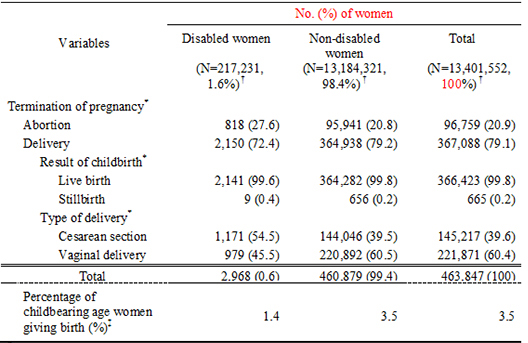1. Simões PP, Almeida RM. Geographic accessibility to obstetric care and maternal mortality in a large metropolitan area of Brazil. Int J Gynaecol Obstet. 2011; 112:25–29.
2. Joseph KS, Liston RM, Dodds L, Dahlgren L, Allen AC. Socioeconomic status and perinatal outcomes in a setting with universal access to essential health care services. CMAJ. 2007; 177:583–590.
3. Lee JY, Kim BK, Eun SJ, Kim Y, Kim YI. Healthcare expenditures of disabled households in Seoul, Korea. J Rehabil Res. 2009; 13:199–223.
4. Kim SH, Byeon YC, Son CG, Lee YH, Lee MG, Lee SH, Kang DW, Kwon SJ, Oh HG, Yoon SY, et al. Survey of disabled in Korea 2011. Seoul: Ministry of Health & Welfare, Korea Institute for Health and Social Affairs;2011.
5. Baker ER, Cardenas DD. Pregnancy in spinal cord injured women. Arch Phys Med Rehabil. 1996; 77:501–507.
6. Nelson JL, Ostensen M. Pregnancy and rheumatoid arthritis. Rheum Dis Clin North Am. 1997; 23:195–212.
7. Walsh-Gallagher D, Sinclair M, Mc Conkey R. The ambiguity of disabled women's experiences of pregnancy, childbirth and motherhood: a phenomenological understanding. Midwifery. 2012; 28:156–162.
8. Sumilo D, Kurinczuk JJ, Redshaw ME, Gray R. Prevalence and impact of disability in women who had recently given birth in the UK. BMC Pregnancy Childbirth. 2012; 12:31.
9. Cunningham FG, Leveno KJ, Bloom SL, Hauth JC, Rouse DJ, Spong CY. Prenatal care. In : Cunningham FG, Leveno KJ, Bloom SL, Hauth JC, Rouse DJ, Spong CY, editors. Williams Obstetrics. 23rd ed. New York, NY: McGraw-Hill;2010. p. 189–214.
10. Nesbitt TS, Larson EH, Rosenblatt RA, Hart LG. Access to maternity care in rural Washington: its effect on neonatal outcomes and resource use. Am J Public Health. 1997; 87:85–90.
11. Getahun D, Ananth CV, Kinzler WL. Risk factors for antepartum and intrapartum stillbirth: a population-based study. Am J Obstet Gynecol. 2007; 196:499–507.
12. Gortmaker SL. The effects of prenatal care upon the health of the newborn. Am J Public Health. 1979; 69:653–660.
13. Showstack JA, Budetti PP, Minkler D. Factors associated with birthweight: an exploration of the roles of prenatal care and length of gestation. Am J Public Health. 1984; 74:1003–1008.
14. Kim KH, Hwang RI, Yoon JW, Kim JS. Prenatal care utilization and expenditure among pregnant women. Korean J Health Policy Adm. 2009; 19:53–65.
15. Song YW, Shin JH, Yoon YS, Jeong HC, Yim HE, Choi BM, Lee JH, Kim HJ, Hong YS, Song JW. Perinatal complications of mothers and neonates resulting from inadequate prenatal care. Korean J Perinatol. 2010; 21:347–355.
16. Kessner DM. Institute of Medicine, Panel on Health Services Research. Infant death: an analysis by maternal risk and health care. Washington: Institute of Medicine;1973. ( National Research Council (U.S.), Contrasts in health status; vol 1).
18. Bobrowski RA, Bottoms SF. Underappreciated risks of the elderly multipara. Am J Obstet Gynecol. 1995; 172:1764–1767. discussion 7-70.
19. Karlsen S, Say L, Souza JP, Hogue CJ, Calles DL, Gülmezoglu AM, Raine R. The relationship between maternal education and mortality among women giving birth in health care institutions: analysis of the cross sectional WHO Global Survey on Maternal and Perinatal Health. BMC Public Health. 2011; 11:606.
20. Gavin NI, Benedict MB, Adams EK. Health service use and outcomes among disabled Medicaid pregnant women. Womens Health Issues. 2006; 16:313–322.
21. Na BJ, Kim HJ, Lee JY. An early stage evaluation of the Supporting Program for Obstetric Care Underserved Areas in Korea. J Korean Med Sci. 2014; 29:764–770.










 PDF
PDF ePub
ePub Citation
Citation Print
Print




 XML Download
XML Download